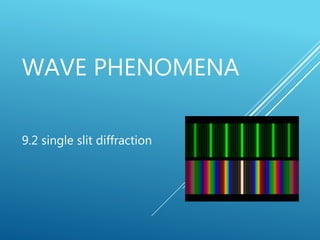
9.2 single diffraction
- 1. WAVE PHENOMENA 9.2 single slit diffraction
- 2. SINGLE EDGE This is the diffraction pattern produced around the edge of a razor blade
- 3. NARROW SLIT
- 4. DIFFRACTION Sketch the variation with angle of diffraction of the relative intensity of light diffracted at a single slit. Hyperlink
- 5. CIRCULAR APERTURE The diffraction fringe pattern produced by a circular aperture.
- 6. DIFFRACTION PATTERNS When plane wavefronts pass through a small aperture they spread out This is an example of the phenomenon called diffraction Light waves are no exception to this
- 7. However, when we look at the diffraction pattern produced by light we observe a fringe pattern, that is, on the screen there is a bright central maximum with "secondary" maxima either side of it. There are also regions where there is no illumination and these minima separate the maxima.
- 8. This intensity pattern arises from the fact that each point on the slit acts, in accordance with Huygen's principle, as a source of secondary wavefronts. It is the interference between these secondary wavefronts that produces the typical diffraction pattern.
- 9. DERIVATION OF EQUATION We can deduce a useful relationship from a simple argument. In this argument we deal with something that is called Fraunhofer diffraction, that is the light source and the screen are an infinite distance away form the slit. This can be achieved with the set up shown in the next figure.
- 11. The source is placed at the principal focus of lens 1 and the screen is placed at the principal focus of lens 2. Lens 1 ensures that parallel wavefronts fall on the single slit and lens 2 ensures that the parallel rays are brought to a focus on the screen. The same effect can be achieved using a laser and placing the screen some distance from the slit.
- 12. Diffraction at a single aperture intensity across screen Single slit distant screen
- 13. Single Aperture Diffraction Pattern EFFECT OF SLIT WIDTH Single Aperture Diffraction Pattern: Narrower Aperture
- 14. EFFECT OF WAVELENGTH θ =λ/b θ =2λ/b
- 15. To obtain a good idea of how the single slit pattern comes about we consider the next diagram
- 16. In particular we consider the light from one edge of the slit to the point P where this point is just one wavelength further from the lower edge of the slit than it is from the upper edge. The secondary wavefront from the upper edge will travel a distance λ/2 further than a secondary wavefront from a point at the centre of the slit. Hence when these wavefronts arrive at P they will be out of phase and will interfere destructively.
- 17. The wavefronts from the next point below the upper edge will similarly interfere destructively with the wavefront from the next point below the centre of the slit. In this way we can pair the sources across the whole width of the slit.
- 18. If the screen is a long way from the slit then the angles θ1 and θ2 become nearly equal. From the previous figure we see therefore that there will be a minimum at P if λ = b sin θ1 where b is the width of the slit.
- 19. However, both angles are very small, equal to θ say, so we can write that θ = λ / b This actually gives us the half-angular width of the central maximum. We can calculate the actual width of the maximum along the screen if we know the focal length of the lens focussing the light onto the screen. If this is f then we have that θ = d / f Such that d = f λ / b
- 20. To obtain the position of the next maximum in the pattern we note that the path difference is 3/2 λ. We therefore divide the slit into three equal parts, two of which will produce wavefronts that will cancel and the other producing wavefronts that reinforce. The intensity of the second maximum is therefore much less than the intensity of the central maximum. (Much less than one third in fact since the wavefronts that reinforce will have differing phases).
- 21. EXAMPLE Light from a laser is used to form a single slit diffraction pattern. The width of the slit is 0.10 mm and the screen is placed 3.0 m from the slit. The width of the central maximum is measured as 2.6 cm. What is the wavelength of the laser light?
- 22. ANSWER Since the screen is a long way from the slit we can use the small angle approximation such that the f in d = f λ / b becomes 3.0m. (i.e. f is the distance from the slit to the screen) The half width of the centre maximum is 1.3cm so we have λ = (1.3 x 10-2) x(0.10 x 10-3) / 3.0 λ = 430 x 10-9 or 430 nm